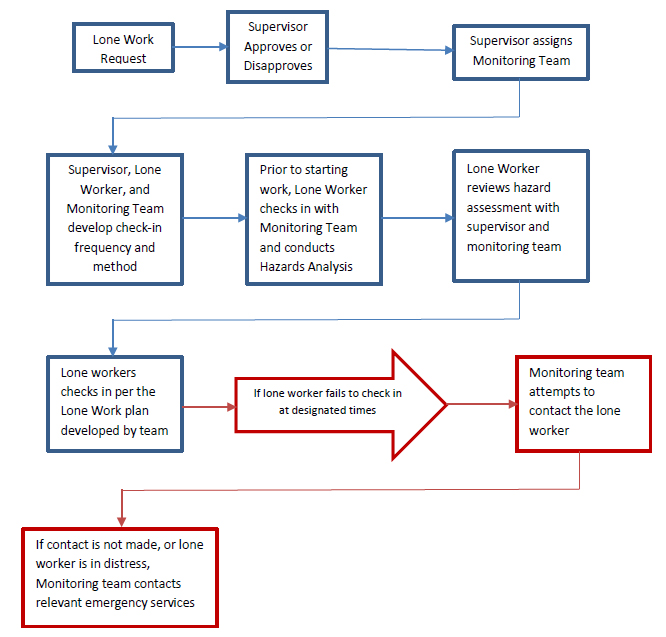Policy Key Points
Purpose: Increase awareness of lone working risks and provide procedures to control hazards.
Applicability: All associates are covered, except those working remotely from home or hotels on office/administrative tasks. Business travelers are also excluded but should notify management when driving long distances.
Lone Worker Definition: A lone worker is anyone working in isolation, out of sight and sound of others, such as co-workers or supervisors.
Permitted Activities: Office/administrative work and specific product assembly/repair without live electrical conductors are allowed. High-risk tasks, such as working near live electrical conductors or operating industrial equipment, are prohibited.
Hazard Analysis:Lone workers must review job hazard analyses (JHAs) before work and report any new hazards to the EHS department.
Purpose and Scope of this Policy
This policy has been created to increase awareness of the risks of lone working and provide procedures to identify and control the hazards related to working alone.
This policy applies to all associates. Personnel who work remotely from home or hotels and who are only performing work of an office or administrative nature, are not considered to be lone workers for the purposes of this policy.
Lone Worker Definition
A lone worker is an associate of Yaskawa America, Inc. who performs tasks in isolation – beyond the sight and sound of others – such as co-workers or supervisors who could otherwise provide quick assistance. Personnel who work remotely from home or hotels and who are only performing work of an office or administrative nature, are not considered to be lone workers for the purposes of this policy.
Associates who are traveling for business are not considered lone workers. However, it's a good idea for an associate to notify their supervisor or another member of management when they are driving long distances for business.
Responsibilities
Managers and Supervisors are responsible for:
- Ensuring processes that are identified as not permitted for lone work are not performed by lone workers
- Where lone work is permitted, coordinate schedules for regular contact with associates who work alone,
- Ensure workers who work alone have adequate means of contact with the assigned monitoring team,
- Providing a system for checking in while they are performing work alone,
- Investigating when a lone worker does not check in or sign out as expected,
- Verify the safety of the associate when the lone worker has not checked in or signed out as expected.
Monitoring Team is responsible for:
- Being available at all times during the period of time they are assigned to a lone worker,
- Acknowledge each alert or contact within 2-minutes of receiving the notification,
- Promptly reaching out to the lone worker to confirm his or her wellbeing and potential need for assistance when lone worker has not checked in or signed out as expected,
- Dispatching nearby coworkers, police, or EMS as may be required for a given incident,
- Document all activities during the response for accurate record keeping.
All Associates are responsible for:
- Notifying their supervisor or another member of management when they will work alone,
- Providing information on their locations, when they expect the work to be completed, and where they will go once the work is completed,
- Assessing risks before beginning to work alone and coordinate this assessment with their supervisor or the EHS department,
- Ensuring they have a cellular phone or electronic monitoring device at all times while working remotely to provide adequate means of remotely contacting the assigned monitoring team when working remotely.
Allowable Lone Work Activities
Office / administrative type work is permitted for lone work. Associates who work from home must perform a risk assessment per Yaskawa’s working from home agreements.
Assembly and repair of products when there are no exposed live electrical conductors.
The following types of work are not permitted to be performed by a lone worker:
- Working on or near exposed live electrical conductors,
- Operating powered industrial vehicles,
- Operating industrial equipment including saws, grinders, drill presses, CNC machinery, or industrial robots (and similar types of manipulators), and
- Operating overhead cranes.
Lone Work in Field Service
Lone work in field service is not permitted. When a Yaskawa associate is dispatched to a field service location, the Yaskawa associate must ensure that a customer representative is always within visual and audible distance from the Yaskawa associate.
The Yaskawa associate must stop work immediately if the customer associate departs from visual and/or audible range.
The Yaskawa associate must review the hazard assessment with the assigned customer representative and review actions that must be taken should an emergency arise.
The customer representative shall not be within the limited approach or arc flash boundaries.
Hazard Analysis
Standard Job Hazard Analyses (JHA) are located in each facilities G:\Safety drive. Associates performing lone work must review the relevant JHA.
Any new or different hazards must be identified and controls implemented prior to performing the work. A copy of this hazard assessment must be sent to EHS@Yaskawa.com.
The hazard analysis must take into consideration the location,
Results of Breaches of Policy
Breaching this policy may result in an injury. Breaches of this policy may result in disciplinary action being initiated in accordance with Yaskawa America's discipline policy.
Training
All associates shall be provided with training related to this policy.
Revision History
| Rev # |
Description |
Release Date |
Approved by |
| 0 |
Initial Release |
2/16/2023 |
Thurwanger |
|
|
|
|
| |
|
|
|
|
|
|
|
|
|
|
|
|
|
|
|
Program Review
| Review Date |
Reviewed by |
Changes Required (Yes/No) |
Revision # if updated |
| 1/16/2024 |
Thurwanger |
No |
|
| 1/21/2025 |
Thurwanger |
No |
|
|
|
|
|
